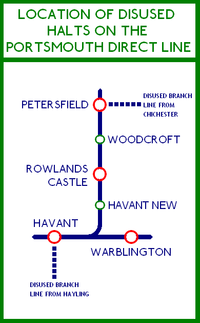Havant New railway station
Coordinates: 50°51′28″N 0°58′10″W / 50.85778°N 0.96944°W
| Havant New | |
|---|---|
| Location | |
| Place | Denvilles |
| Area | Borough of Havant |
| Operations | |
| Original company | London and South Western Railway |
| Platforms | ? |
| History | |
| 1 January 1859 | Opened |
| 24 January 1859 | Closed |
| Disused railway stations in the United Kingdom | |
|
Closed railway stations in Britain A B C D–F G H–J K–L M–O P–R S T–V W–Z | |
|
| |
Havant New was a temporary terminus between Havant and Rowlands Castle on the Portsmouth Direct Line: a temporary platform, erected by the L&SWR who were granted permission to run all trains along the line by its independent venture owners, but which did not reach Portsmouth, which started a dispute with the LB&SCR which owned the only railway south of Havant.
Battle of Havant

In 1858, the two local railway companies started the "Battle of Havant". The London, Brighton and South Coast Railway ran the London to Portsmouth Line via Hove, and refused to allow the London and South Western Railway to use any of that track to reach Portsmouth. The LB&SCR blocked the line just north of the intended junction, prompting the L&SWR to open a temporary station at Havant. The station was opened on 1 January 1859.[1][2] Passengers would travel from Havant New in a horse-drawn omnibus to Hilsea, bypassing Havant. The passengers could then carry on into Portsmouth by train. After two years the companies came to an agreement and the L&SWR were allowed access to the disputed line.[3] The station closed on 24 January 1859.[1][2][4]
The site today
Nothing remains of the station today; the site is marked only by some old semaphore signal posts, some slates and a platelayers' hut. The station was the only one on the line built of blue bricks. The surrounds were not developed at the time of the station's existence so having fulfilled its political function it closed, in 1859.
See also
References
Notes
- 1 2 Butt 1995, p. 115.
- 1 2 Quick 2009, p. 205.
- ↑ "Information Sheet No. 9: The Coming of the Railway". Buriton Heritage Bank. August 2001. Retrieved 2012-02-20.
- ↑ Clinker 1988, p. 61.
Sources
- Butt, R. V. J. (1995). The Directory of Railway Stations: details every public and private passenger station, halt, platform and stopping place, past and present (1st ed.). Sparkford: Patrick Stephens Ltd. ISBN 1-8526-0508-1. OCLC 60251199.
- Clinker, C.R. (1988) [1978]. Clinker's Register of Closed Passenger Stations and Goods Depots in England, Scotland and Wales 1830–1980 (2nd ed.). Bristol: Avon-Anglia Publications & Services. ISBN 0-905466-91-8. OCLC 655703233.
- Quick, Michael (2009) [2001]. Railway passenger stations in Great Britain: a chronology (4th ed.). Oxford: Railway and Canal Historical Society. ISBN 978-0-901461-57-5. OCLC 612226077.
- Map sources for Havant New railway station
- "Recollections of the station". Bygone Havant. 2003. Archived from the original on 2005-05-07. Retrieved 2012-02-20.
- Southern E-Group's page including details of the battle